Database of luminescent minerals
ZIRCON
Chemical formula: ZrSiO4
Family: Silicates
Status: IMA-GP
Crystal system : Tetragonal
Display mineral: OUI
Associated names (luminescent varieties, discredited names, synonyms, etc.): alvite, cyrtolite, malacon,
Luminescence:
Longwave UV (365nm) colors: |
Pale Yellow , Tawn , Yellowish , | ||
Intensity LW:Weak | |||
Midwave UV (320nm) colors: |
Orangy yellow , | ||
Intensity MW:Medium | |||
Shortwave UV (254nm) colors: |
Orangy yellow , Yellowish White , Pale Yellow , Yellow , Dark Orange /Tawn , Tawn , Greenish , Yellowish , | ||
Intensity SW:Strong | Frequency SW:Often | ||
Daylight picture
Shortwave (254nm) picture
Do you have a photo of this mineral you would like to see in the gallery? Contact us!
Phosphorescence (in the common sense of the term) observable with the naked eye:
No data
Tenebrescence: OUI

Thermoluminescence: OUI
Comments:
Variété alvite (contenant du Hf, Th et des terres rares: OC et LW: vert; SW: Rouge-orangé;
Variété cyrtolite (zircon partiellement métamicte contenant U et souvent Th et des terres rares: OC: jaune;
variété malacon (zircon très métamicte, souvent brun: OL: orange;
Zircon is ometimes thermoluminescent
Activator(s) and spectrum:
Activator(s): Centres dûs aux effets des radiations, (UO2)2+ (ion Uranyle) en impureté, Cr3+, Fe3+, Sm3+, Eu3+, Dy3+, Ho3+, Er3+, Tb3+, Nd3+, Yb3+, Tm3+,
Peaks in the spectrum (nm):
Dy3+ : 472, 481, 486nm (UO2)2+ : 506, 523, 550nm Fe3+ : 750 nm, Δ = 110–120 nm and τ = 3–5 ms Neutron and alpha irradiation : 575 nm, peak half-width (Δ) = 120–130 nm, and decay time (τ) = 30–35 µs
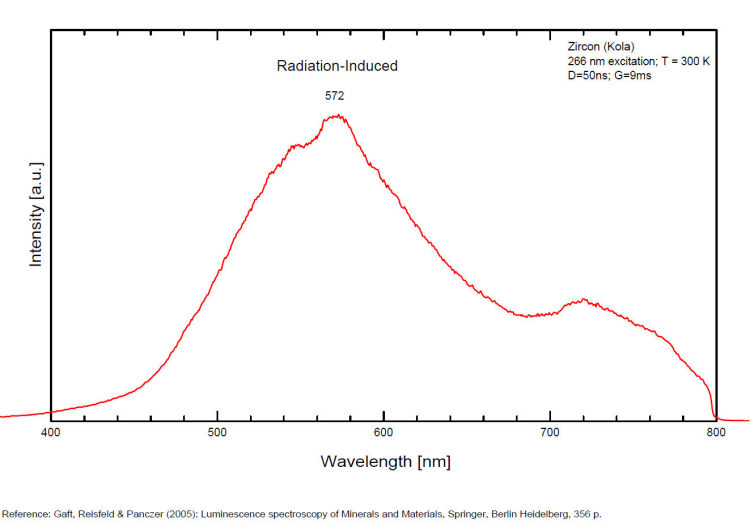
Spectrum: Michael Gaft, Petah Tikva, Israel. Plot: Institute of Mineralogy, University of Vienna, Austria, with permission of the authors.
Spectrum Galery:
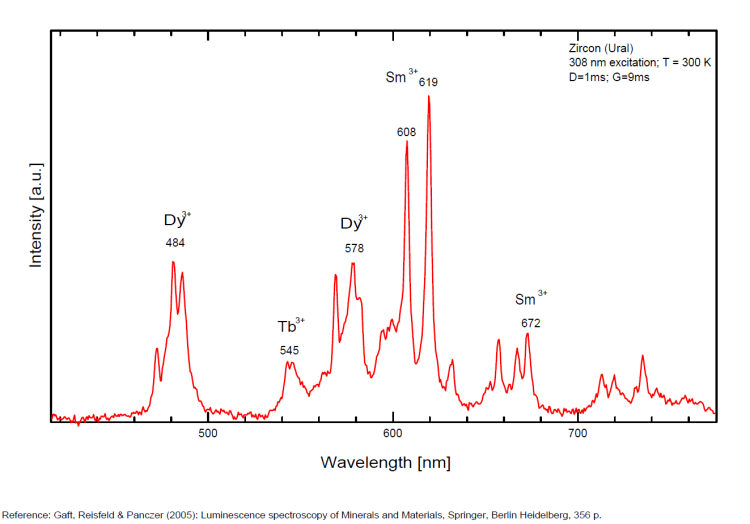
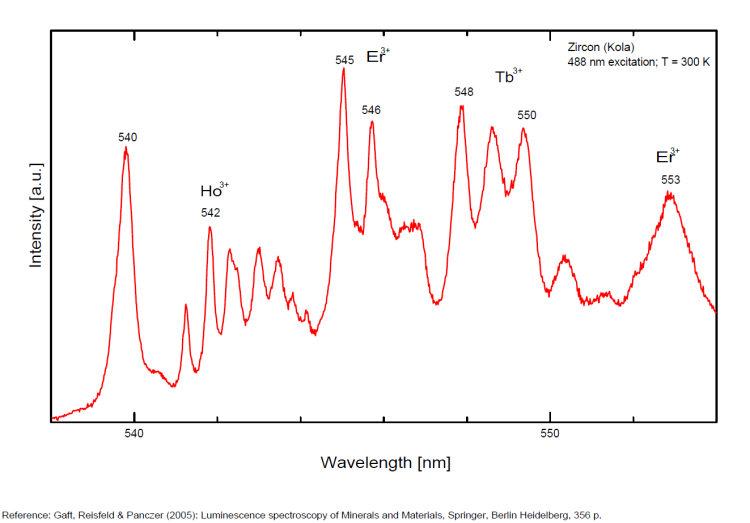
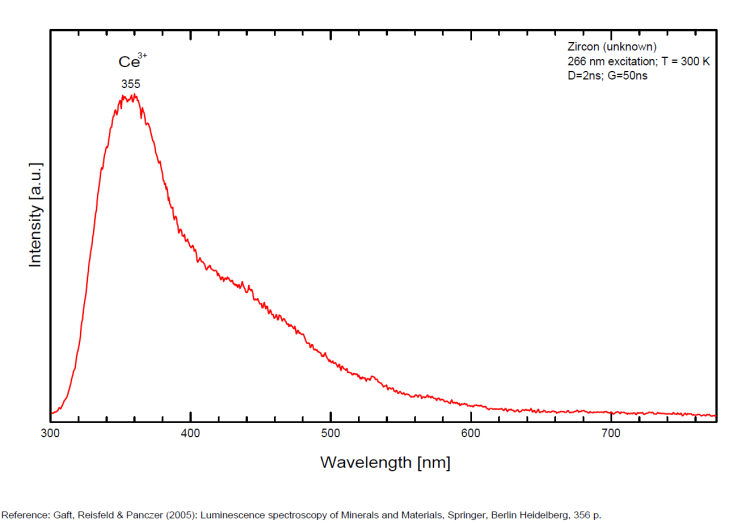
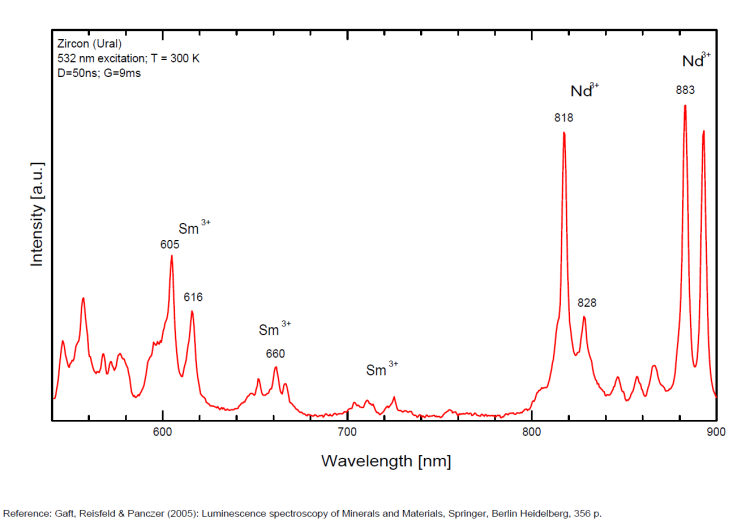 ...
...Comments on spectrum and activators:
The crystal chemistry of zircon strongly favors the incorporation of REE in Zr4+ site. The REE impurities become luminescent in this crystallographic environment. The steady-state luminescence in natural zircons is dominated by broad emission arising from radiation induced centers and narrow emission lines of Dy3+ (Trofimov 1962; Tarashchan 1978). These emissions obscure the spectra of other REE. The thermal treatment enables to solve this problem in certain cases using the fact that the intensity of broad band luminescence quickly decreases after heating at 700 °C–800 °C, while the intensities of the REE lines remain nearly constant (Shinno 1986, 1987). Even after heating the samples not all the REE can be identified by steady-state spectroscopy since the weaker luminescence lines of certain REE are obscured by stronger luminescence of others. For example, the luminescence of Pr3+ is difficult to detect because the lines of Sm3+, Dy3+ and Nd3+ hide its radiative transitions. In turn, Tb3+ conceals luminescence of Tm3+ and so on. Different suppositions are made in previous studies and even the question about yellow luminescence connection with intrinsic or impurity defect remains open. The yellow band with peak wavelength (λmax) = 575 nm, peak half-width (Δ) = 120–130 nm, and decay time (τ) = 30–35 µs is connected with neutron and alpha irradiation. Activators: broadband emission from radiation induced centers and lines from Dy3+ (Trofimov in Gaft) masking other lines from REE in Zr4+ site.
The red band with λmax = 750 nm, Δ = 110–120 nm and τ = 3–5 ms is connected with Fe3+. (M. Gaft, I. Shinno, G. Panczer and R. Reisfeld, Laser-induced time-resolved spectroscopy of visible broad luminescence bands in zircon, Mineralogy and Petrology, vol76, 2002)
The intensity of the broadband luminescence quickly decrease after heating at 700-800° while the lines from REE stay constant (Shinno in Gaft).
Best localities for fluorescence (*):
- OstSkogen Quarry, Tuften Quarry, Arent Quarry, Tvedalen, Langesundfjord, Larvik Plutonic complex, Larvik, Vestfold, Norway;
- Zirconium prospect, Stokkøya, Langesundsfjorden, Larvik, Vestfold, Norway;
- Granit Quarry, Tuften, Tvedalen, Larvik, Vestfold, Norway;
- Store Kufjord, Seiland Island, Alta, Finnmark, Norway;
- Goiás, Brazil;
- Peixe, Peixe alkaline complex, Tocantins, Brazil;
- Kipawa alkaline complex, Les Lacs-du-Témiscamingue, Témiscamingue RCM, Abitibi-Témiscamingue, Québec, Canada;
- Mount Malosa, Zomba District, Malawi;
- Lovozero Massif, Kola Peninsula, Murmanskaja Oblast, Northern Region, Russia;
- Chelyabinsk Oblast, Southern Urals, Urals Region, Russia;
- Astor Valley, Astor District, Gilgit-Baltistan, Pakistan;
- Poudrette quarry, Mont Saint-Hilaire, La Vallée-du-Richelieu RCM, Montérégie, Québec, Canada;
- Mud Tank, Alcoota Station, Central Desert Region, Northern Territory, Australia;
(*)The data are not exhaustive and are limited to a few remarkable localities for fluorescence
Bibliographic reference for luminescence:
- The Henkel Glossary of Fluorescent Minerals, Dr. Gerhard Henkel, Published by the FMS, 1989 ,
- Fluorescence: Gems and Minerals Under Ultraviolet Light, Manuel Robbins, 1994, Geoscience Press, ISBN 0-945005-13-X ,
- The World of Fluorescent Minerals, Stuart Schneider, Schiffer Publishing, 2006, ISBN 0-7643-2544-2 ,
- Luminescence Spectroscopy of Minerals and Materials, M. Gaft, R. Reisfeld, G. Panczer, Springer Editor, ISBN: 10 3-540-21918-8 ,
- Luminescent Spectra of Minerals, Boris S. Gorobets and Alexandre A. Rogojine, Moscow, 2002 ,
- Minershop.com ,
Reference for luminescence on the Internet:
- The Langesundsfjord: history, geology, pegmatites, minerals, Alf Olav Larsen, Bode Verlag Gmbh, 2010 ISBN 978-3-925094-97-2
- Geonieuws (MKA), January 2010
- MONT-SAINT-HILAIRE, History, Geology, Mineralogy, Laszlo HORVATH, The Canadian Mineralogist, Special Publication 14, 2019
- Fluorescence of zircons, 3 types noted. Aoki, (Yamagata Daigaku Kiyo, Shizen Kagaku 10, 219-226 (1981) Chem. Abstr. 96, no. 2, 9532 (1982).
- Study of fluorescence spectra. Aoki, (Yamagata Daigaku Kiyo, Shizen Kagaku 10, 325-333 (1982)(English)) Chem. Abstr. 97, no. 2, 9276 (1982).
Images:
- https://www.mindat.org/photo-628677.html
- https://www.mindat.org/photo-769956.html
- https://www.mindat.org/photo-241569.html
- https://www.mindat.org/photo-347532.html
- https://www.mindat.org/photo-1010894.html
- https://www.mindat.org/photo-359723.html
- https://www.mindat.org/photo-367305.html (green fluorescing zircon covered by meta-autunite)
- https://www.mindat.org/photo-398627.html
- https://www.mindat.org/photo-487840.html
- https://www.mindat.org/photo-487878.html
- https://www.mindat.org/photo-633895.html
- https://www.mindat.org/photo-713656.html
Mineralogical reference on the Internet:
 http://www.mindat.org/show.php?name=Zircon
http://www.mindat.org/show.php?name=Zircon
 http://webmineral.com/data/Zircon.shtml
http://webmineral.com/data/Zircon.shtml
Internet Search:
 Image search on 'Google Images'
Image search on 'Google Images'
 Search for documents in all languages on Google
Search for documents in all languages on Google
A request providing no result means only that no such reference exists in the database, but it does not mean that what you are looking for does not exist, just not to our knowledge. If you think you have found an error or omission, please let us know via the contact page being sure to cite the source of information.



